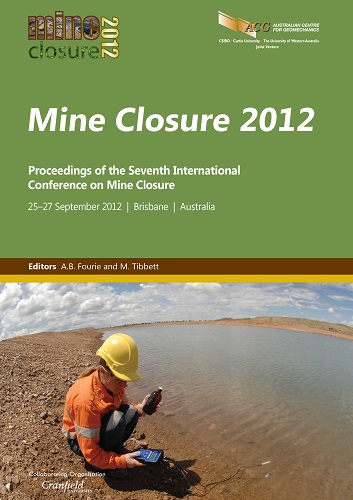Investigation and evaluation of remediation and closure alternatives for the Avoca mining site in Ireland

|
Authors: Olsen, RL Paper is not available for download Contact Us |
DOI https://doi.org/10.36487/ACG_rep/1208_25_Olsen
Cite As:
Olsen, RL 2012, 'Investigation and evaluation of remediation and closure alternatives for the Avoca mining site in Ireland', in AB Fourie & M Tibbett (eds), Mine Closure 2012: Proceedings of the Seventh International Conference on Mine Closure, Australian Centre for Geomechanics, Perth, pp. 265-278, https://doi.org/10.36487/ACG_rep/1208_25_Olsen
Abstract:
At the Avoca district in Ireland, mining for copper and pyrite occurred for over 230 years and ceased in 1982. Historic mining, milling, and smelting at the East Avoca and West Avoca mining sites, and tailings disposal at the Shelton Abbey site, left contaminated waste materials (spoils) on the surface and in the waters. Large open pits accumulate water and provide infiltration to underground workings. Surface waters and waterways are impacted by high metal concentration acid rock drainage from runoffs, acid mine discharges from adits and contaminated groundwater from diffuse flow. Unsafe conditions exist due to abandoned shafts and adits, unstable piles, and walls in open pits. In addition, this area contains many historic structures of industrial archaeological, historical, and cultural importance, many of which are in need of repair. A feasibility study was prepared with the overall objective to develop realistic, sustainable, cost-effective, and achievable integrated management plans for the site that address human and ecological concerns, safety and physical hazards, features of historical significance, future uses, public concerns and long-term site monitoring and management. A range of effective and innovative remediation alternatives were prepared and evaluated using processes modified and enhanced from the USA Environmental Protection Agency (USEPA) Superfund programme. Keys to being able to prepare and recommend effective and innovative alternatives are the collection of appropriate information, conduction of appropriate studies, and use of appropriate evaluation tools. In the case of the Avoca evaluations, some of the successful investigations and evaluations included developing site conceptual geochemical, hydrogeological, and risk models relating sources, pathways, and receptors to focus investigations and alternative evaluations. Defining the diffuse (nonpoint groundwater) contribution to the metal concentrations in rivers using tracer studies was important. Other key investigations included performing in vitro bioavailability and speciation studies to define site-specific and appropriate clean up levels for metals and performing advanced characterisation studies (e.g. electronmicroprobe analyses) to understand metal mobilisation and acid generation. In addition, detailed human health and ecological risk assessments were performed to evaluate remediation goals. Integrating public safety and protection of historical features into remediation plans and by using a systematic alternative evaluation process that also incorporated public concerns, sustainability, land use, and site compatibility were also important key evaluations. As a result of these investigations and evaluations, effective, innovative, site-wide integrated remediation alternatives were developed. Capital, operation/maintenance, and long-term monitoring costs were also prepared for each alternative. Alternatives evaluated include passive and active treatment of acid mine discharges, various cover systems for spoils, water management techniques, capture and treatment of nonpoint sources, and stabilisation techniques for pits and adits/shafts.
References:
Gallagher, V. and O'Connor, P.J. (1997) Characterization of the Avoca Mine Site: geology, mining features, history, and soil contamination study. Geological Survey of Ireland Technical Report MS/97/1.
GWP Consultants (2008) Health and Safety Audit, Avoca Mine Site. Prepared for CDM on behalf of the Minister, April 2008.
Irish EPA (2001) Regulatory Limits for Dangerous Substances in Surface Water, Water Quality (Dangerous Substances) Regulations, S.I. No. 12 of 2001, Minister of State at the Department of the Environment and Local Government, Ireland.
USEPA (1988) Guidance for Conducting Remedial Investigations and Feasibility Studies Under CERCLA. EPA/540/G-89/004.
USEPA (2008) Standard Operating Procedure for an In Vitro Bioaccessibility Assay for Lead in Soil. EPA 9200.1-86.
© Copyright 2025, Australian Centre for Geomechanics (ACG), The University of Western Australia. All rights reserved.
View copyright/legal information
Please direct any queries or error reports to repository-acg@uwa.edu.au
View copyright/legal information
Please direct any queries or error reports to repository-acg@uwa.edu.au